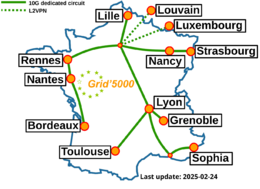Grid5000:Home
|
Grid'5000 is a large-scale and flexible testbed for experiment-driven research in all areas of computer science, with a focus on parallel and distributed computing including Cloud, HPC and Big Data and AI. Key features:
Grid'5000 is merging with FIT to build the SILECS Infrastructure for Large-scale Experimental Computer Science. Read an Introduction to SILECS (April 2018)
Older documents:
|
Random pick of publications
Five random publications that benefited from Grid'5000 (at least 2517 overall):
- Sirine Sayadi, Venceslas Douillard, Nicolas Vince, Mario Südholt, Pierre-Antoine Gourraud. Distributing human leukocyte antigen HLA database in histocompatibility: a shift in HLA data governance. Exploration of Immunology, 2022, 2, pp.749-759. 10.37349/ei.2022.00080. hal-03747555 view on HAL pdf
- Leo Cazenille, Nicolas Bredeche, José Halloy. Automated optimization of multilevel models of collective behaviour: application to mixed society of animals and robots. Bioinspiration and Biomimetics, 2022, 17 (5), pp.055002. 10.1088/1748-3190/ac7fd1. hal-03842222 view on HAL pdf
- Marie Delavergne, Geo Johns Antony, Adrien Lebre. Cheops, a service to blow away Cloud applications to the Edge. Research Report RR-9486, Inria Rennes - Bretagne Atlantique. 2022, pp.1-16. hal-03770492v2 view on HAL pdf
- Bastien Confais, Gustavo Rostirolla, Benoît Parrein, Jérôme Lacan, François Marques. Mutida: A Rights Management Protocol for Distributed Storage Systems Without Fully Trusted Nodes. Transactions on Large-Scale Data- and Knowledge-Centered Systems, 13470, Springer Berlin Heidelberg, pp.1-34, 2022, Lecture Notes in Computer Science, 10.1007/978-3-662-66146-8_1. hal-03822471 view on HAL pdf
- Aimen Djari, Emmanuelle Anceaume, Sara Tucci-Piergiovanni. Sycomore ++ , un registre distribué orienté graphe auto-adaptatif. AlgoTel 2022 - 24èmes Rencontres Francophones sur les Aspects Algorithmiques des Télécommunications, May 2022, Saint-Rémy-Lès-Chevreuse, France. pp.1-4. hal-03656546 view on HAL pdf
Latest news
![]() Cluster "estats" is now in the default queue in Toulouse
Cluster "estats" is now in the default queue in Toulouse
We are pleased to announce that the estats cluster of Toulouse (the name refers to Pica d'Estats) is now available in the default queue.
As a reminder, estats is composed of 12 edge-class nodes powered by Nvidia AGX Xavier SoCs. Each node features:
Since it is not a cluster of server-class machines (unlike all current other Grid'5000 nodes), estats runs a different default system environment, but other common functionalities are the same (kadeploy etc., except kavlan which is not supported yet).
For the experimentations, it is recommended to deploy Ubuntu L4T.
More information in the Jetson page.
The cluster was funded by a CNRS grant.
-- Grid'5000 Team 9:51, March 6th 2024 (CEST)
![]() The big variant of Debian 12 "Bookworm" environments is ready for deployments
The big variant of Debian 12 "Bookworm" environments is ready for deployments
We are pleased to inform you that the big variant of Debian 12 (Bookworm) environments is now supported for deployments in Grid'5000. Check `kaenv3 -l debian12%` for detailed information.
Notably, the NVIDIA driver has been updated to version 535.129.03, and CUDA has been upgraded to version 12.2.2_535.104.05_linux for the amd64 architecture.
The default environment available on nodes will continue to be debian11-std for the foreseeable future.
Please refer to the updated wiki documentation¹ for guidance on Debian 12-min|nfs|big usage.
¹: https://www.grid5000.fr/w/Getting_Started#On_Grid.275000_reference_environments
-- Grid'5000 Team 14:21, Jan 22nd 2024 (CEST)
![]() Cluster "montcalm" is now in the default queue in Toulouse
Cluster "montcalm" is now in the default queue in Toulouse
We have the pleasure to announce that the "montaclm" cluster is now available in the default queue of the Toulouse site, which makes the site full-fledged again!
This cluster consists of 10 HPE Proliant DL360 Gen10+ nodes with 2 CPUs Intel Xeon Silver 4314 (16 cores per CPUs), 256 GB of DDR4 RAM, and 894GB SSD.
Jobs submitted on the Toulouse site will run by default on this cluster.
Beside the "montcalm" cluster, the "edge-class" cluster "estats" is still available in the testing queue for now.
In order to support the SLICES-FR project, the site infrastructure has been funded by CNRS/INS2I and the "montcalm" cluster has been funded by University Paul Sabatier (UT3).
-- Grid'5000 Team 10:30, 18 Jan 2024 (CET)
![]() New "edge-computing"-class nodes in Toulouse's testing queue: cluster Estats with 12 Nvidia AGX Xavier SoCs
New "edge-computing"-class nodes in Toulouse's testing queue: cluster Estats with 12 Nvidia AGX Xavier SoCs
A new cluster named "estats" is available in the testing queue of the Toulouse site, composed of 12 "Edge computing"-class nodes.
Estats is composed of 12 Nvidia AGX Xavier SoCs¹. Each SoC features:
The 12 modules are packaged in a chassis manufactured by Connecttech⁴.
Since it is not a cluster of server-class machines (unlike all current other Grid'5000 nodes), estats runs a different default system environment. This environment includes Nvidia's Linux for Tegra²³ overlay on top of the Grid'5000 standard environment. This means:
This default environment does not include the required Tegra-specific version of Cuda.
To benefit from the whole Nvidia stack with e.g. the specific Cuda version and DL accelerators support for Nvidia Tegra, it is advised to deploy on the node the Nvidia-supported Ubuntu 20.04 OS with the full L4T support, using kadeploy. You can use the ubuntul4t200435-big environment. E.g.:
ftoulouse$ oarsub -q testing -t exotic -p estats -t deploy -l nodes=1 -I
ftoulouse$ kadeploy3 ubuntul4t200435-big
This tutorial page explains how this ubuntul4t200435-big environment is built and how to...
Grid'5000 sites
Current funding
As from June 2008, Inria is the main contributor to Grid'5000 funding.
INRIA |
CNRS |
UniversitiesIMT Atlantique |
Regional councilsAquitaine |


